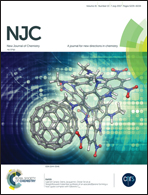Effective removal of colourless pollutants and organic dyes by Ag@AgCl nanoparticle-modified CaSn(OH)6 composite under visible light irradiation
Abstract
A high-efficiency nanocube-like composite, Ag@AgCl/CaSn(OH)6 (Ag@AgCl/CSH), was successfully synthesized via an ultrasonic-assisted deposition-photoreduction method. The as-synthesized samples were characterized by X-ray diffraction (XRD), scanning electron microscopy (SEM), elemental mapping, transmission electron microscopy (TEM), high-resolution transmission electron microscopy (HRTEM), UV-vis diffuse reflectance spectroscopy (DRS), X-ray photoelectron spectroscopy (XPS), energy dispersive spectroscopy (EDS), BET analysis, photoluminescence emission spectroscopy (PL), and photocurrent (PC) methods. Photodegradation experiments for the decomposition of single dye, multiple dyes, and colorless organic pollutants, such as tetracycline (TC) and bisphenol A propane (BPA), were carried out under visible-light irradiation. Among the as-synthesized samples, the Ag@AgCl(20.5 wt%)/CSH composite exhibited optimal photocatalytic activities. The experimental conditions, including solar light and water source, were also considered to study their effects on photodegradation. The trapping experiment was carried out to clarify the possible mechanism of enhanced photocatalytic performance, which could be attributed to surface plasmon resonance (SPR) effects via the introduction of Ag@AgCl nanoparticles. After five recycling experiments, highly efficient photocatalytic activity was still maintained, demonstrating that the as-synthesized composite possessed excellent reusability and stability. It can be anticipated that the Ag@AgCl/CSH composite will have great potential in real applications such as in the treatment of wastewater.



 Please wait while we load your content...
Please wait while we load your content...